Just about everyone’s seen them at some point – little black and yellow-striped balls with stubby wings that fly as gracefully as bricks don’t. They’re almost iconic of bees to the point where most depictions of bees, especially those geared towards kids, are actually the humble bumble bee.
This is a highly misunderstood critter, so before you go setting the yard on fire trying to get rid of bumble bees (or “bumblebees”), let’s take a look at who they are, why they are, and what they do.
See Also: How to Get Rid of Bees (When Necessary)
Getting to Know Bumble Bees
Bumble bees can be lazy fliers, but they’re no bumblers. In fact, there are over 350 known species in the Bombus genus that are found natively in the Americas, Europe, most of Asia, and the northern tip of Africa.
They’re highly social, even though you’re likely to only see one or two at any given time.
Related: Flying Stinging Insect Identification
What Do Bumble Bees Look Like?
Bumble bees are a peculiar sight, with plump, round abdomens that tend to be quite fuzzy and have yellow and black markings. The most common ones have yellow and black stripes, but some species have brown instead of black, white instead of yellow, or large patches of yellow.
The Red-tailed bumble bee (Bombus lapidarius) of Central Europe is a good example of how varied bumble bees can be. They have a mostly black body and reddish-orange on the back half of their abdomen.
They usually measure around 3/4 to an inch long, have bristly legs, and the worker bees have a pollen basket (known as a corbicula) on their hind legs. But what makes them so fascinating is their stubby wings which have left scientists baffled for centuries as to how these critters can fly.
However, the key is that bumble bees use dynamic stall to achieve efficient lift, even during inclement weather (this factor was often overlooked in trying to figure out if bumble bees should even be able to fly).
Bumble Bee Nesting Habits
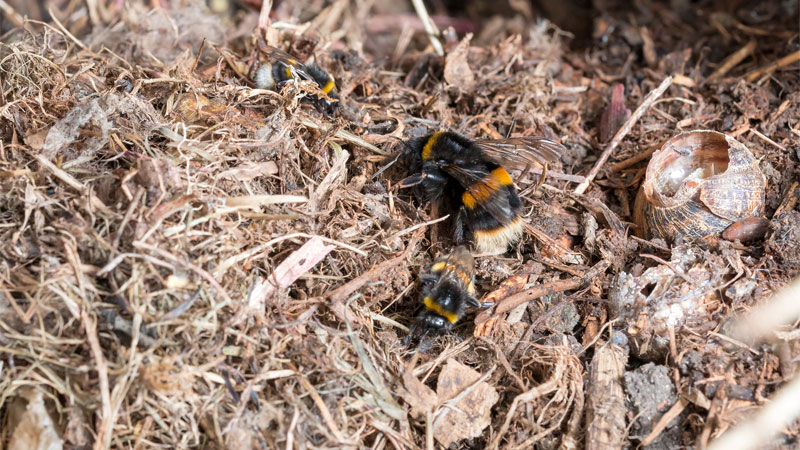
One of the peculiar habits of bumble bees is the fact that their colonies live in nests, as opposed to the hives of most bees. It all starts with a queen bee that has survived the winter. She’ll search for a suitable nesting spot to establish her new colony.
Common nesting grounds are abandoned burrows, cavities under rocks or debris. On rarer occasions it could be in walls, woodpiles, or even human structures such as a shed, attic, or unused vehicles.
Unless the new bumblebee nest is already insulated, the queen will line it with grass or moss. Several wax cells are constructed to store pollen and nectar before she lays five to 20 eggs for the first brood.
After a month, this brood hatches into workers which collect pollen and nectar to make honey so the queen can focus on producing more eggs.
Bumble bees are much hardier than honey bees and are able to forage at temperatures as low as 26 degrees (most other bees won’t forage below 61 degrees).
Throughout the summer, the colony continues to grow, with a full colony containing 50 to as many as 400 bees. By late summer, the queen lays several unfertilized eggs which hatch into drones.
Once fall hits, several queens emerge and go on a mating flight with the drones. Those queens lucky enough to mate will then find shelter and go into hibernation in November.
Why Do Bumble Bees Forage Alone?
It might seem strange that social insects such as bumble-bees forage alone. However, there’s an actual strategic reason behind it.
Each bee flies solo, which can reduce the risk of huge losses from predators. Additionally, they never trade their food, which can protect the colony from toxins or pesticides.
Some species even leave a scent mark on flowers they’ve visited so others from the hive don’t visit the empty flowers. The scent will wear off by the time the plant is worth returning to.
More importantly, food is stored in wax or brood cells and only in enough quantities to last a few days. This discourages raids from skunks and other predators which have easier access to the ground-based nests. Compare this to honey bees which build up high but are often targeted by bears and other animals due to the abundance of food.
Are Bumble Bees Aggressive?
You might have heard the song about a kid catching a baby bumblebee and killing it when they get stung. It’s actually a very accurate representation of how humans treat these critters.
In reality, bumble bees are some of the most docile bees out there. You can safely let one land on your arm if you don’t spook it. They tend to avoid humans and animals when possible and would rather go about their business than get into a fight (which may be part of the reason they’re sometimes called humble bees).
Don’t be surprised or concerned if one decides to come over to investigate when you’re eating something sweet. However, there’s one exception to this rule, and that’s when they feel the nest is being threatened.
See Also: How to Eliminate Sweat Bees
Do Bumble Bees Sting?
As with all bees, female bumble-bees are able to sting and will do so if threatened. They have a smooth stinger, so it doesn’t tear off when stinging.
This means they can sting multiple times, but it also means less venom is delivered by the sting. A single bumble bee sting can be a little painful, but is non-threatening in most cases.

There are two exceptions to this rule, however.
- People who are allergic to bee stings can suffer anaphylactic shock. This may lead to hives, nausea, or more severe symptoms like the inability to breathe or even death in extreme cases. The more you get stung by bumble bees, the more likely you will develop at least some level of allergic reaction to the venom.
- The other exception is when you get too close to or disturb their nest. This can be a matter of proximity, going over the nest with a lawnmower, or gardening too close to the nest. A threatened nest is the only time you’ll see a bumble bee swarm, and it’s often only around five to ten bees. However, they’ll aggressively and repeatedly sting until they feel the nest is safe. This can lead to a buildup of venom in the body sufficient enough to cause side effects.
Do Bumble Bees Make Honey?
Yes, they do. However, bumble bee honey isn’t edible when it comes to humans.
For this reason, it’s uncommon for beekeepers to nurture colonies. However, farmers often will, as they help with the pollination of plants.
Why Are There Bumble Bees Around My House?
Bumble-bee queens aren’t burrowers. They’ll actively seek out existing holes and cavities in which to hibernate or start a new colony. Between the garden, sheltered spaces, and any existing damage to your home, it can be a paradise of options for the queen.
Can Bumble Bees Damage My Home?
No, contrary to what a lot of sites claim, bumble bees won’t harm your home or any other structure. If you see a bee creating holes in wood, that’s a carpenter bee, NOT a bumble bee.
However, just because they won’t do any damage doesn’t mean you want a nest in your walls. Indoor nests can lead to a higher risk of your or your family being stung.
Bumble Bee Benefits
It’s important to note that bumble bees are incredibly important to the environment. They should never be killed if you can help it. These gals are one of the most important pollinators in the world. In fact, bumblebees are the only natural pollinators of many plant species.
While honey bees create edible honey, they’re actually far less important than bumble bees when it comes to the environment. Sadly, they’re also dying out, just like the honey bee. Preservation of these insects should always be your top priority.
Bumble Bee vs Carpenter Bee
Carpenter bees are often thought of as the evil twins of bumble bees, but there are differences.
- Carpenters are generally all black and have smooth, shiny exoskeletons.
- Bumble bees never make holes in wood (or anything else) but carpenters actively make holes in wood.
Bumble Bee vs Honey Bee
It’s not that difficult to tell honey bees from bumble bees once you know what to look for.
- Bumble bees can harvest small-mouthed flowers and are often evolved to be the sole pollinator of some plants. Meanwhile, honey bees can only harvest from open flowers.
- Bumble bees are plump and furry. Honey bees are thinner, smaller, and less furry.
- Bumble bees live on or near the ground while honey bees live high up.
- Honey bee colonies can be up to 200 times larger than bumble bee colonies.
- Honey bees have barbed stingers and die after stinging once. Bumble bees have smooth stingers and can sting multiple times.
How to Get Rid of Bumble Bees
Now that we’ve had a good look at the humble-bee, let’s take a look at ways to get rid of them. Obviously, you shouldn’t be concerned if you see one or two in the yard, but running into a nest is never good.
Plus there’s the possibility the nest is in your home, shed, or even your car, making removal a necessity.
WARNING:DO NOT Kill Bumble Bees!
Bumble bees are in a state of rapid decline for several reasons we both know and have yet to confirm. For example, the rusty patched bumble bee (Bombus affinis) is considered critically endangered. It’s already lost more than 87 percent of its population in the Eastern US and Ontario.
On the west coast, Franklin’s bumble bee (Bombus franklini) is so critically endangered that the remaining population inhabits a 190 by 70 mile strip in northern California and Oregon. There hasn’t been a sighting of one since 2006, leading many to believe the species is already extinct.
A third species, the yellow-banded bumble bee (Bombus terricola) is one of the most fascinating species out there, with the ability for a colony to continue after the queen has died. However, despite high intelligence and adaptability, it’s still listed as vulnerable.
And while we’ve only covered three of an estimated 50 species living in the US, it’s easy to see why conservation of all bumble bees is so important.
The Save America’s Pollinators Act has been on the table since 2013 but may eventually see a vote. This act would make it illegal to kill pollinating bees such as honey bees, bumble bees, and mason bees.
Even without the bill being voted on, conservation efforts exist worldwide. Many species of bumble bee have become extirpated (locally extinct), or are on the endangered or threatened lists. Not only that, but it’s already illegal in many parts of the US to kill certain bees without a license.
As a result, we will NOT discuss the use of traps, insecticides, zappers, or other lethal methods here.
Reminder of the Risk of Collateral Deaths
While we won’t suggest ways to kill bumblebees, we do want to address the risk of bees getting killed when you’re eliminating a pest insect. There are three things you can do to reduce the risk of innocent victims.
- When fighting bugs that pierce or chew plants, use a neem soil soak. This systemic treatment will kill the targets but bees, ladybugs, and other beneficial critters will be safe.
- Try to use any contact insecticides at dawn or dusk when bees are least active. Avoid pesticides that could leave toxic residue on flowers.
- As mentioned earlier, bumblebees are quite intelligent and won’t share food. Thus, if you’re using something like borax bait against ants, only a bumblebee that comes in direct contact will be at risk.
This is why we here at RMC are all about using natural, controllable remedies when possible. You never know how many potential allies will be harmed or killed as collateral damage when using chemical solutions.
How to Get Rid of a Bumble Bee Nest
Getting rid of a bumble bee nest is a two-step process. First, you must get rid of the bees, then get rid of the nesting holes. The following methods can be used in both the home and yard.
Note that bumble bee colonies die out in the winter, so it’s often best to just let them run their course and go straight to step 2 after.
The following are some easy methods to convince bumble bees it’s time to move house.
#1 – Soapy Water and Essential Oils
It’s no secret that soapy water can suffocate any insect on contact, but we don’t want to actually kill bumble bees, so let’s take advantage of evaporation to turn a killer into a repellent.
Mix a teaspoon or two of Dawn dish soap or pure castile soap (the two least toxic options) into a quart of water. Now, let’s add a few drops of essential oil. You can use citronella, citrus, lemongrass, peppermint, or tea tree oil.
Spray this on your flowers and around the nesting areas at night, dusk, or dawn. Try not to get it in the nest itself or to let it come in contact with any bees. The water will soon evaporate, leaving the dried soap to help the oils stick to whatever surfaces you sprayed.
This method is nice because the strong smell repels a wide range of critters. At the same time, it creates a pleasant smell for humans. It can take a few days, but the queen and her colony will voluntarily relocate to another spot where there’s not so much stench.
#2 – Cinnamon
Cinnamon is toxic to bees in large quantities, although a tiny amount can actually protect them from parasites. Knowing this, you can sprinkle a little ground cinnamon cinnamon around the nest entrance. The scent will warn the bees it’s time to move on, yet the powder won’t harm them.
#3 – Garlic
Garlic sprays can actually kill bumble bees. However, making one and spraying plants and areas around the next site works well as a safe bee repellent. You can also plant alliums (garlic, onions, and their ornamental relatives) for longer-lasting repellent action.
#4 – Mothballs
The stench of mothballs can scare bumble bees away. However, you need to be careful using them due to the toxic chemicals used in traditional mothball products. We suggest this be a last resort, and don’t let let the mothballs dissolve into the ground.
#5 – Professionals
When bees get into the walls, they can be difficult to remove safely. The best option is to call a local beekeeper, who can relocate the nest safely. Barring that, an exterminator will either move the nest or eliminate it (make sure they have any necessary permits to do this).
Can I Use Vinegar?
This is a bit of a tough question, because most vinegar recipes out there are designed to kill bumble bees, not repel them. However, you can use a 1:1 ratio of vinegar and water (possibly with mint oil) instead of soapy water. Two things to keep in mind, however:
- You’ll want to use white vinegar, preferably cleaning grade. This is more acidic and less likely to attract flies and other scavengers than the sweeter-smelling apple cider vinegar.
- Vinegar is highly acidic and can harm plants if you get any on them or use too much on the nearby soil. As a result, this method is better used on structures such as walls or woodpiles.
Keeping Bumble Bees Away
Once the bumble bees are gone, you’ll need to ensure they don’t return to previous nesting spots. This is a very simple matter.
#1 – Use Exclusion Methods
Make sure there are no holes or other damage to your home, shed, etc. Seal any problem spots and screen over pipe or wire entry points. You’ll also want to remove any abandoned bird nests and fill in any abandoned holes, such as mouse dens, on the property.
#2 –Use Complimentary Planting
Growing basil, citronella, cucumber, eucalyptus, geraniums, marigolds, mint, pennyroyal, wormwood, or carnivorous plants will naturally keep the bumble bees from wanting to get near a certain area.
#3 – Bumble Bee Houses
These are little wooden structures, usually with a tin roof, that have entry points perfectly sized for bumble bees. Place them at the far end of your property in fall or winter. The fertile queens will happily use them for their new nests.
- How to Get Rid of Hawks - March 8, 2024
- How to Get Rid of Pill Bugs (Rolly Pollies) - March 1, 2024
- How to Get Rid of Groundhogs (Woodchucks) - February 5, 2024

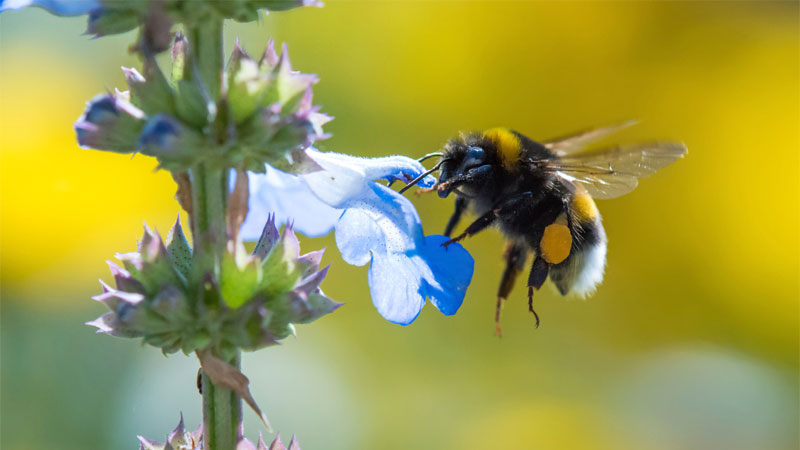
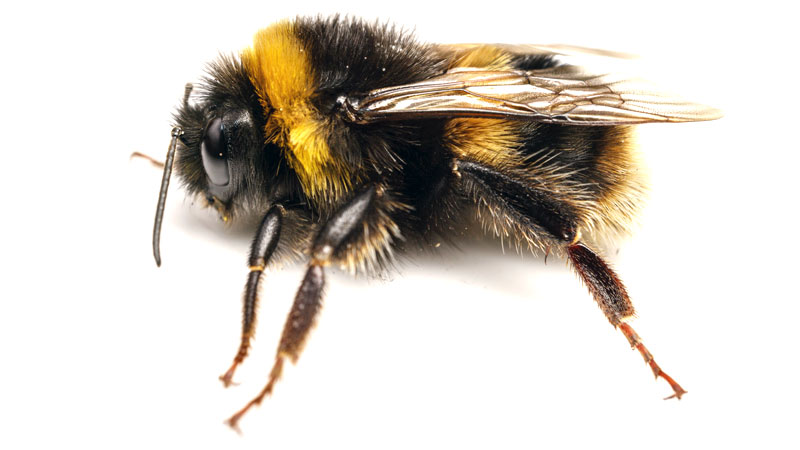
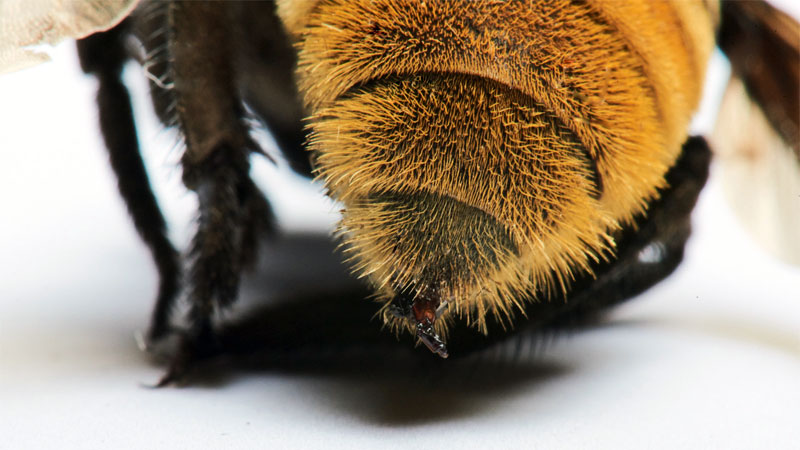
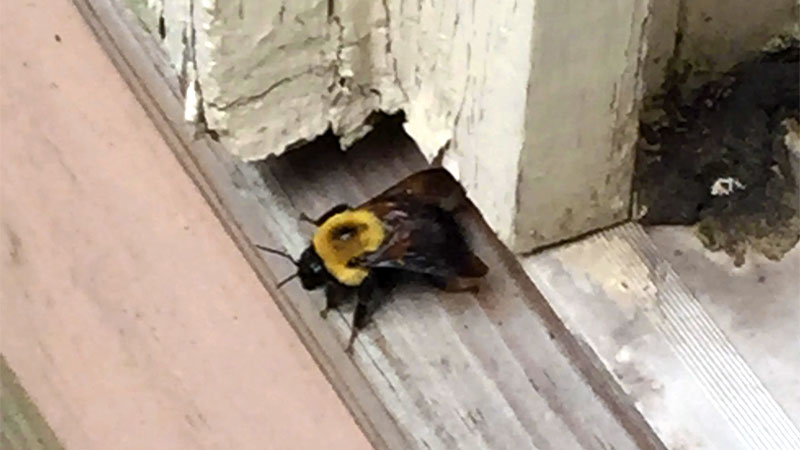
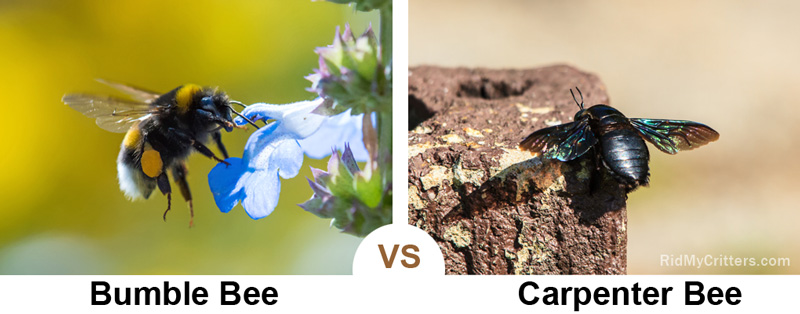
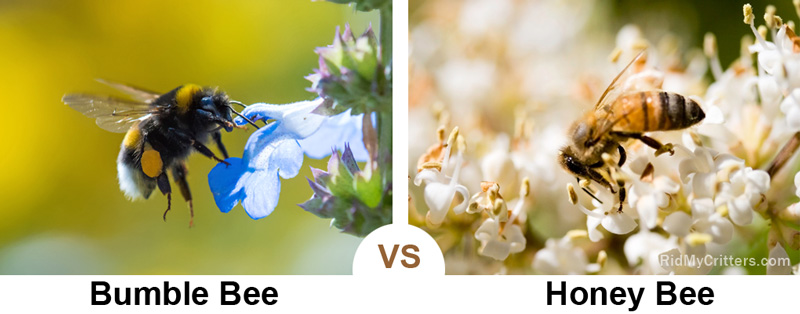
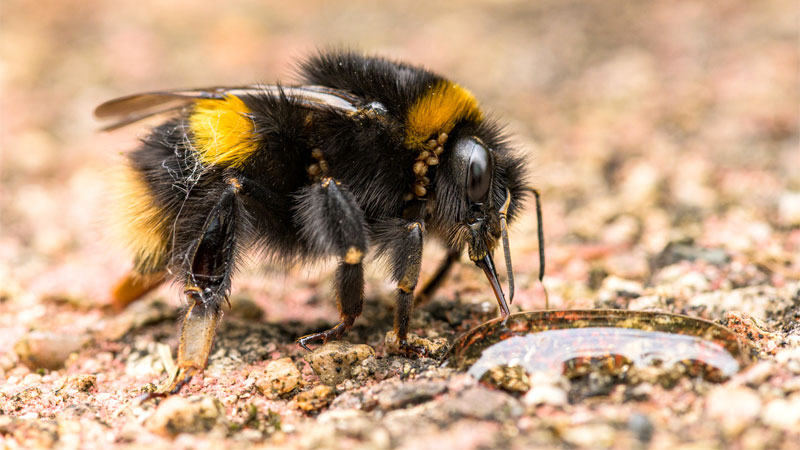
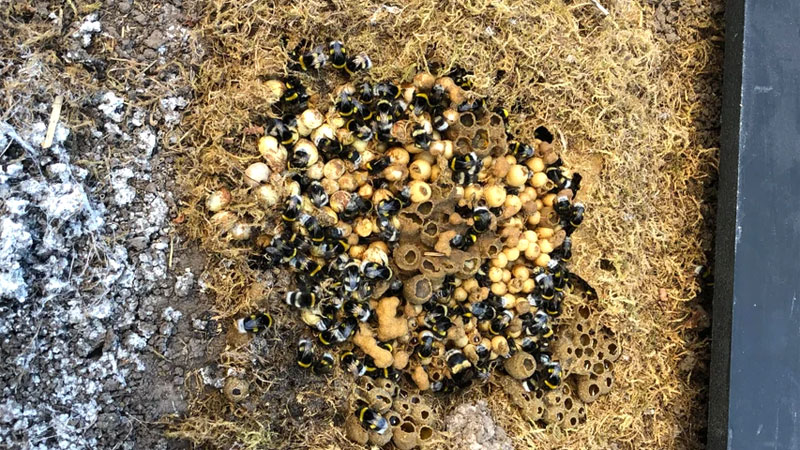
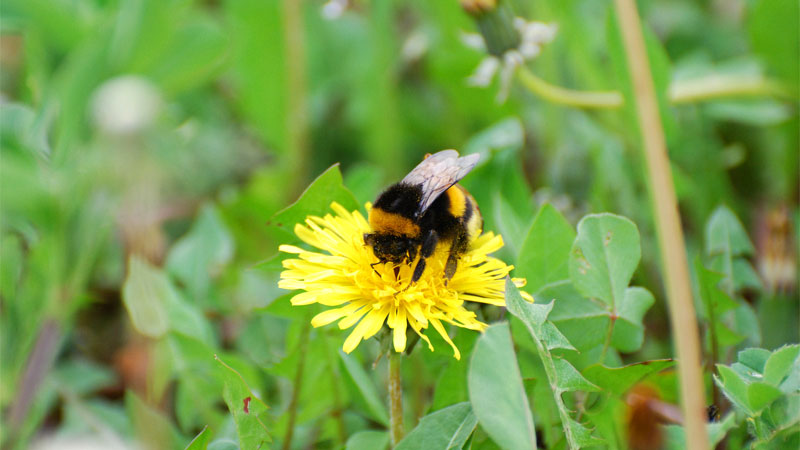
I have one bumblebee in my car. I have opened the windows and doors to try to get it to leave. It flies around in the back window but doesn’t leave. Sometimes going under the back window shelf. Any suggestions?
Since bees have a natural attraction to light, try covering the rear window with a towel. The bee should eventually make its way out an open door. If not, take a rolled up newspaper or piece of cardboard and try gently “shoo-ing” it towards an opening.
Thank you for such wonderful information! I’ve just purchased a home that has been vacant. There is a hole in the wood siding where I noticed a bumble bee entering. There are no flowers present near the the hive nor have I detected any on the immediate property. The hole is near the only entrance to the house and in a space I am enclosing for an addition. I don’t want to remove the bees from the property but also concerned about angry bees so near my door. I love the relocation strategy of the bumble bee house. What would you say is the most effective of your above suggestions?
Moving a bumble bee nest is difficult and they won’t always survive no matter how experienced you are. However, here’s a method you can try if you don’t mind being patient.
1) Check any local and state ordinances to make sure you can move the nest without special certification. If the law requires one, you will need to contact a pest control company and let them know you only want to move the colony elsewhere on your property.
2) Choose a new, sheltered spot for the nest. Near a garden or flowerbed is ideal because the bees will prefer being near flowers.
3) Prepare a makeshift nest. A bee box, ceramic flowerpot, or even a bird box works great. Add some pesticide-free moss, grass clippings, or similar materials. You’ll also need to make sure the opening is protected from rain.
4) Now, this is the tricky part. You want to remove the nest intact, but since it’s behind the siding, this will be extremely difficult. Since you plan to build an addition here anyway, it’s not a big deal to remove the siding. However, I would strongly suggest you consult a local beekeeper for tips before attempting this, simply because removing the siding MAY damage the nest.
The keeper may suggest smoking the nest or using other methods to make the bees sluggish. If you’re lucky, they may even be willing to come help (but this is pretty rare for bumble bees). Listen carefully to their advice, and if they warn you not to move the nest on your own and aren’t willing to do so themselves, you may need to call a pest control company for assistance. Be sure to verify they can do relocations before hiring. It will cost some money, but is well worth it.
That said…
6) If you’re able to shift the nest (which may not be possible considering it’s in a wall), be careful not to tip it and carefully place it in your prepared container.
7) In the event you don’t think you can safely remove the nest as-is, wait until around late October or November. At this point, the only living member of the colony will be the queen. If she’s successfully mated, she’ll have gone into hibernation and it may be possible to salvage enough of the nest to move her safely.
8) Once the nest (or queen) is safe in the container, gently carry it to the spot you designated.
You likely won’t know if the transplant was successful until the following spring if you had to wait for the queen to hibernate. As there’s a fair percentage of colony failures even in undisturbed nests, don’t beat yourself up if the transplant attempt fails.
Because the nest is in a wall, things are a lot more complicated, but not impossible. Bumble bees won’t cause structural damage and will only attack if threatened, but you don’t want them trapped inside the new addition. Hopefully, you’ll be able to move the nest successfully.
Please let us know how it went and any additional steps the keeper or pest control agent advised. Not only do we love to hear about personal conservation efforts, but your experience may be of benefit to others in similar circumstances.